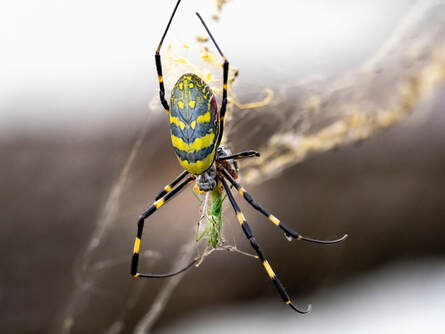|
You may have noticed media reports on this very large spider. Are you getting more questions from customers afraid of spiders falling from the sky? Have you thought, “should I be worried about this”? Experts agree that people should not fear this gentle giant. A little bit of knowledge can help calm down worries and equip you to answer questions you may get about the joro spider. For many of us across the U.S., spring has arrived with some much needed sunshine and warm weather. Unfortunately, rising temperatures have also triggered the emergence of some undesirable 6 and 8 legged creatures. Along the east coast, this includes the presence of a new, menacing looking spider. But do not be afraid, looks can be deceiving. Coined the ‘joro spider’ (Trichonephila clavata), this palm-sized arachnid (another term scientists use for spider) invaded from Japan and took up residence in Georgia back in 2014. Recently, a scientific publication claimed that this species had the potential to invade the entire east coast due to its cold hardiness versus other related, native species. The popular press really ran with the finding, crafting sensationalized headlines to warn the public that large spiders would soon be literally “falling from the sky”—pushing the joro spider into the limelight, most likely, undeservedly. Joro spiders are native to Japan and eastern Asia, and experts think they entered the U.S. in shipping containers. Using websites such as https://www.inaturalist.org/, which allows citizens to report sightings of joro spiders, scientists estimate the current range of this invasive species to be somewhere around 15,500 square miles.
In spite of a striking appearance (in Japanese folklore, the joro spider turns into a striking woman to prey on unsuspecting men), they do not harm humans or animals and are considered a very passive spider. Although you probably should not handle one, bites are unlikely. Additionally, experts have found that this species has little to no effect on regional agricultural practices or ecosystem functions. They might even be beneficial, as they feed on some pest insects, and might serve as an additional food source for birds and other predators. Thus, unlike other more destructive invasive insects, spiders, and ticks you may have heard of (e.g., spotted lanternflies, fire ants, brown marmorated stink bugs, and Asian longhorned ticks) researchers think the best thing to do with this spider is simply leave it alone. Right now, there have been joro spider sightings in Georgia, Tennessee, South Carolina, North Carolina, and Oklahoma. They can easily move due to human activity and travel. Time will tell how far they will establish, but over the next decade or so, researchers estimate that the spider’s range will increase in all directions due to their ability to withstand milder climates. There is no reason to kill these spiders when you see them. Although if you see one outside reported ranges, you could report it to help scientists map their spread throughout the U.S. Additionally if you need assistance with identification, you can work with an extension specialist at a major academic university in your state. You may be tempted to kill spiders when you see them, especially non-native, giant ones that look threatening. However, try not to judge a book by its cover here. This may be a lucky situation where an invasive species actually benefits the area it inhabits. Let’s hope so because, like it or not, it looks like joro spiders are here to stay. For more information on joro spiders, check out this nice article by The Washington Post.
0 Comments
Your comment will be posted after it is approved.
Leave a Reply. |
Bug Lessons BlogWelcome science communicators and bug nerds!
Interested in being a guest blogger?
Archives
November 2023
Categories
All
|

